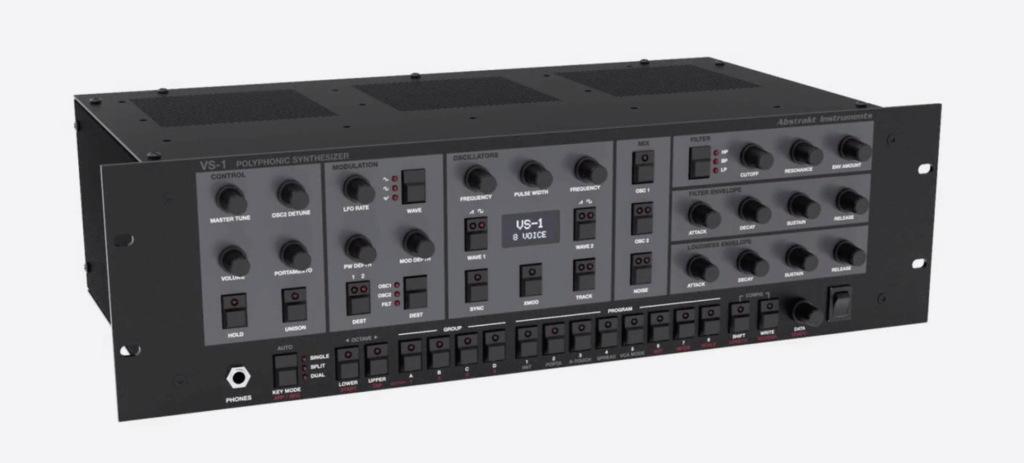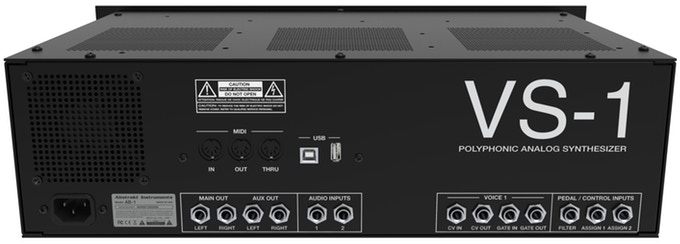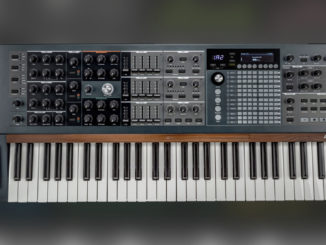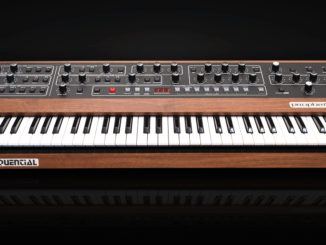Abstrakt Instruments VS-1 is a new polyphonic analog Synthesizer with up to 8 voices based on the circuits of the legendary Oberheim OB-X.
Supporting a Kickstarter project does not mean you will get a product afterward. You primarily support the developer, his work, and the project. Kickstarter is always like gambling. You get it, or you don’t. And yes, projects can drag on and take a long time until they’re delivered.
With the Abstrakt Instruments Kickstarter project, it took four years from the pledge to delivery. More precisely, Abstrakt has started shipping its DIY Oberheim OB-X clone/replica, initially announced in 2020.
In December 2023, Brian Castro from Abstrakt Instruments said:
It’s been an interesting week…
We have officially started shipping VS-1 DIY Kits. We decided to ship a batch of kits to United States destinations first to make sure they arrive in good shape. The package is heavy – mostly due to the steel enclosure. The kits are double-boxed and also have corner protectors, but they are still quite heavy.
We want to make sure there are no issues and make sure the first natch arrives in good shape and the corners are not slammed and damaged. Only basic kits without additional parts kits have started shipping. Kits with full parts kits will start shipping next week. All kits will be shipped before the holiday season.
It is good to see that the project is now completed, and the backers can build their VS-1 (OB-X clone/replica).
___________________________________________________________________________________________
Article January 15, 202o
What a week already, and the NAMM hasn’t started yet. The next big news comes from Abstrakt Instruments, which has announced a clone of the Oberheim OB-X Synthesizer but with modern technology and as a DIY kit. According to the developer, the VS-1 combines vintage analog sound with modern features, designed for those that find modern synths over-perfected.
The core is divided into two sections: a discrete analog and a digital side with a 600MHz ARM-Cortex-M7 based system that includes all the memory and I/O interfacing. The VS-1 will be available in 4, 6 and 8 voice versions.
Analog Engine
Based on the discrete analog design of the iconic Oberheim™ OB-X, the VS-1 utilizes many of the same design trade-offs, including a signal path comprised of discrete transistors, op-amps, & 3080 OTA’s utilizing through-hole components. Combined with modern digital control, a clean & simple interface, and packed into a 3U rack… this is the essence of the VS-1.
Each voice consists of two discrete analog VCOs and a 12dB OTA Filter (LP/BP/HP) and VCA. The VCO offers a saw, and the pulse width can be adjusted from 0% to 100%. VCO 1 can be modulated by VCO2 (crossmod), and VCO2 can be hard-synced to the frequency of VCO1. VCO’s can also be modulated by two analog LFO’s, two digital LFO’s per-voice, and a DADSR 5-stage envelope generator. It also comes with an analog white & pink noise generator.
12dB OTA Filter The classic resonant 12dB multimode filter is the desert island filter, simply awesome in a polyphonic synth. The classic OB-X had a fixed lowpass mode, the OB-R has lowpass, bandpass & highpass modes. The VCAs are based on the 3080 OTA and also include a stereo panning VCA with modulation. The spread control makes it easy to pan voices across the stereo field.
Modulation
On the modulation side, you get a dedicated analog ADSR for each voice for the filter and VCA. In addition, there is a global five-stage DADSR with (20) modulation destinations. Two global analog LFOs are onboard with triangle, square, and S&H waveforms can be sent to VCO1 frequency and pulse width, VCO2 frequency and pulse width, and filter cutoff.
Analog polyphonic portamento gives a natural clustering effect between voices as the analog components are never perfectly matched. Although this requires many additional components it has been included – another example of small imperfections that impart character. In addition, digital portamento with both fixed rate and fixed time modes is also included.
Digital Side
Besides the analog engine, the VS-1 offers a powerful digital core based on a 600MHz ARM-Cortex-M7-based System on a module. Here, it offers two additional LFOs per voice with triangle, sawtooth, reverse sawtooth, square, and random waves with (20) destinations. LFO’s also have dedicated attack-decay envelopes and can be free-running or synced to the arpeggiator, sequencer, or MIDI clock for tempo-synced effects. But that’s not all.
Further, it offers different key modes (bi-timbral, single, split or layer), up to 15 alternate tunings and an autotune function. It also features a 64-step polyphonic sequencer with up to 240 patterns, different arpeggiator modes, and the possibility to create chords.
MIDI Channel aftertouch can be routed to (16) destinations, including VCO1 frequency, VCO2 frequency, filter cutoff, loudness, and LFO modulation amount. Eight velocity response curves have also been included to suit playing styles and to compensate for controllers with non-linear aftertouch response. MPE is not yet on board but a stretch goal. A high-resolution OLED display gives you visual feedback.
Connections Of The Abstrakt Instruments VS-1
- Main Audio Outputs—Unbalanced, 1⁄4 inch audio outputs. These are the main stereo outputs for the synth. They carry Part 1 and also Part 2 if no cables are connected to the Aux Audio Output jacks.
- Aux Audio Outputs—Unbalanced, 1⁄4 inch audio outputs. Connect audio cables to these jacks if you want separate stereo outputs for Part 2 (for splits and Layers).
- Audio Inputs—Unbalanced, 1⁄4 inch audio inputs. These are inputs to the filters of Voices 1 & 2. Each input has a preamp with gain.
- CV & Gate I/O—Voice 1 only.
- Filter CV Input—Part 1 only
- Assignable CV Inputs—Assign to any parameter.
- USB Host—Bidirectional MIDI communication with a computer. The VS-1 is a Class Compliant USB device and does not require additional drivers when used with Mac OS or Windows.
- USB Peripheral—Direct connection to a usb-enabled midi keyboard controller.
- MIDI In, Out, and Thru—Standard 5-pin MIDI DIN connectors.
Abstrakt Instruments VS-1 is available now for pre-order on Kickstarter for $995 USD as a DIY kit. You need to pledge up to $3495 USD for the built version of the 8 voice version.
More information here: Abstrakt Instruments







Sounds and look great. Does that price include the same terrible after purchase support that customers had to endure with the Avalon bass synth??
Apparently they intend to hire one person, yes a single person for after sale support as noted in their Kickstarter video. As impressive as this synth sounds, I’m still a bit surprised that it has been funded.
Kickstarter:Buy it now get it when you are dead!
or not for people who don’t have patience 😉
It’s almost the same price like the original Oberrheim obx8 desktop….
Who should buy this?
Ah shit, know i get it. The diy is about 1K. So that’s ok
A day late and a dollar short. The world has moved on.
Oberheim knock off!
For that price I’ll wait for the behringer clone that will probably be £150
you forgot a 0 😉 the UB-Xa is already £1000 😉
Can’t see this going somewhere, with all the Oberheim stuff that’s been released since these years have passed. The Oberheim craze has passed, it seems… Rightfully so, I think. Time to look ahead once more!
The word ‘clone’ is like a red flag waving at a bull !
Let’s get some terminology straight:
– a’replica’ is an exact copy of an object. This term does not apply to any modern commercial synths, as they need to comply with current electrical and safety standards. A replica may be made with good or bad intentions, but usually only found in musea, or with people longing for authenticity.
– a ‘clone’ is one that ‘appears’ to be a copy of an original “form”, that “looks” very much like something else. We can’t really use that definition on sound instruments. None of them we could call clones that way. So let’s amend the definition from ‘seeing’ to ‘hearing’: a ‘clone’ is one that “appears” to be a copy of original “electronic circuitry”, that “sounds” and “functions” very much like it. With this definition the VS-1 is an example of a clone, but it does live up to modern standards (power, safety, avoid hazardous materials, MIDI, eurorack compatibility, 19″ dimensions). In other words ‘similar’, not exact.
– The term ‘knock-off’ is an informal noun, meant to describe: a “copy or imitation, especially of an expensive product, with the intention to rob or steal from the original maker.”
Given the long stopped commercialisation of the original design, the enhancements beyond complying to standards, and the price for a fully build instrument, the term ‘knock off’ is not on its place here.
There are some clones for OB-X around these days, none of them are knock-offs.
I uses clone and replica for everything what is old, vintage and no longer in production. Knockoff for everything which is still in production and sold by the original designer.
That comes pretty close to the definition, I agree. The VS-1 is surely a clone, and not a knock-off as suggested by someone.